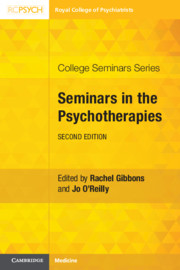Book contents
- Seminars in the Psychotherapies
- College Seminars Series
- Seminars in the Psychotherapies
- Copyright page
- Reviews
- Contents
- Contributors
- Foreword
- Preface
- Part I Therapy Theory and Practice
- Section 1 Psychodynamic Psychotherapy
- Section 2 Other Forms of Psychotherapy
- Chapter 7 Cognitive Behavioural Therapy and Dialectical Behavioural Therapy: An Introduction
- Chapter 8 Brief Psychodynamic Psychotherapies
- Chapter 9 Systemic Family Therapy
- Chapter 10 Cognitive Analytic Therapy (CAT):
- Chapter 11 Group Analytic Psychotherapy and the Group Analytic Model: A Clinician’s Guide
- Chapter 12 Mentalizing in Psychiatric Practice
- Part II Applied Psychotherapeutic Thinking
- Index
- References
Chapter 11 - Group Analytic Psychotherapy and the Group Analytic Model: A Clinician’s Guide
from Section 2 - Other Forms of Psychotherapy
Published online by Cambridge University Press: 27 May 2021
- Seminars in the Psychotherapies
- College Seminars Series
- Seminars in the Psychotherapies
- Copyright page
- Reviews
- Contents
- Contributors
- Foreword
- Preface
- Part I Therapy Theory and Practice
- Section 1 Psychodynamic Psychotherapy
- Section 2 Other Forms of Psychotherapy
- Chapter 7 Cognitive Behavioural Therapy and Dialectical Behavioural Therapy: An Introduction
- Chapter 8 Brief Psychodynamic Psychotherapies
- Chapter 9 Systemic Family Therapy
- Chapter 10 Cognitive Analytic Therapy (CAT):
- Chapter 11 Group Analytic Psychotherapy and the Group Analytic Model: A Clinician’s Guide
- Chapter 12 Mentalizing in Psychiatric Practice
- Part II Applied Psychotherapeutic Thinking
- Index
- References
Summary
Group analytic psychotherapy is an important psychotherapeutic treatment, both in the NHS and the private sector. Many patients seek help for difficulties in social relating and maintaining intimate and supportive relationships with families, colleagues, friends and partners. Relationships are key to how we live, function, develop and respond to adversity. Harmful patterns of relating and difficulties with intimacy predispose to mental health difficulties, and impact powerfully on the ability to recover. For many people presenting in distress and seeking psychotherapy, group analytic psychotherapy should be viewed as a treatment of choice.
- Type
- Chapter
- Information
- Seminars in the Psychotherapies , pp. 135 - 146Publisher: Cambridge University PressPrint publication year: 2021



